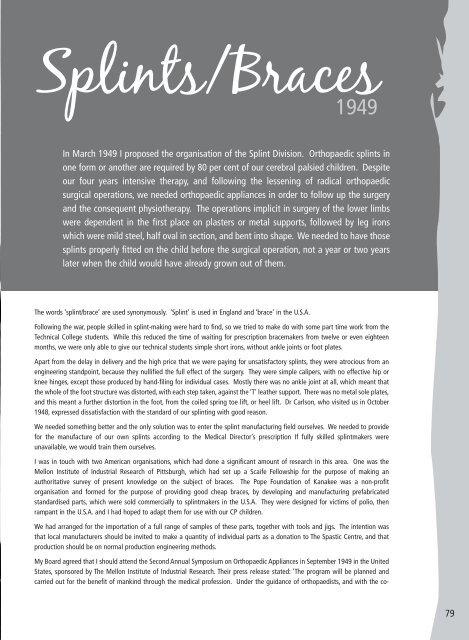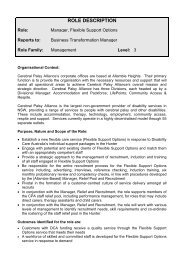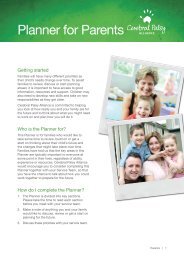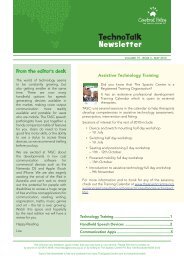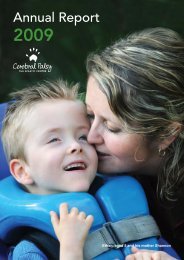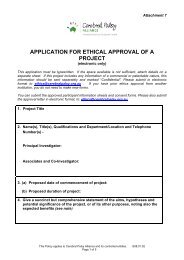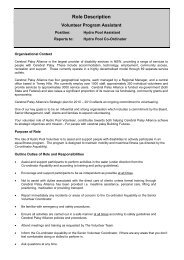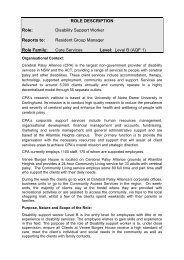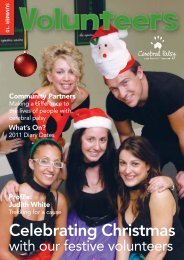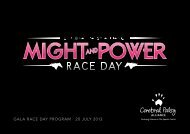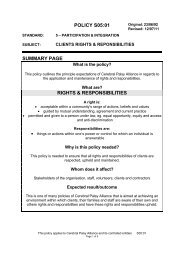'Nothing is impossible' - Part 2, chapter 4-8 - The Spastic Centre
'Nothing is impossible' - Part 2, chapter 4-8 - The Spastic Centre
'Nothing is impossible' - Part 2, chapter 4-8 - The Spastic Centre
You also want an ePaper? Increase the reach of your titles
YUMPU automatically turns print PDFs into web optimized ePapers that Google loves.
Splints/Braces<br />
1949<br />
In March 1949 I proposed the organ<strong>is</strong>ation of the Splint Div<strong>is</strong>ion. Orthopaedic splints in<br />
one form or another are required by 80 per cent of our cerebral palsied children. Despite<br />
our four years intensive therapy, and following the lessening of radical orthopaedic<br />
surgical operations, we needed orthopaedic appliances in order to follow up the surgery<br />
and the consequent physiotherapy. <strong>The</strong> operations implicit in surgery of the lower limbs<br />
were dependent in the first place on plasters or metal supports, followed by leg irons<br />
which were mild steel, half oval in section, and bent into shape. We needed to have those<br />
splints properly fitted on the child before the surgical operation, not a year or two years<br />
later when the child would have already grown out of them.<br />
<strong>The</strong> words ‘splint/brace’ are used synonymously. ‘Splint’ <strong>is</strong> used in England and ‘brace’ in the U.S.A.<br />
Following the war, people skilled in splint-making were hard to find, so we tried to make do with some part time work from the<br />
Technical College students. While th<strong>is</strong> reduced the time of waiting for prescription bracemakers from twelve or even eighteen<br />
months, we were only able to give our technical students simple short irons, without ankle joints or foot plates.<br />
Apart from the delay in delivery and the high price that we were paying for unsat<strong>is</strong>factory splints, they were atrocious from an<br />
engineering standpoint, because they nullified the full effect of the surgery. <strong>The</strong>y were simple calipers, with no effective hip or<br />
knee hinges, except those produced by hand-filing for individual cases. Mostly there was no ankle joint at all, which meant that<br />
the whole of the foot structure was d<strong>is</strong>torted, with each step taken, against the ‘T’ leather support. <strong>The</strong>re was no metal sole plates,<br />
and th<strong>is</strong> meant a further d<strong>is</strong>tortion in the foot, from the coiled spring toe lift, or heel lift. Dr Carlson, who v<strong>is</strong>ited us in October<br />
1948, expressed d<strong>is</strong>sat<strong>is</strong>faction with the standard of our splinting with good reason.<br />
We needed something better and the only solution was to enter the splint manufacturing field ourselves. We needed to provide<br />
for the manufacture of our own splints according to the Medical Director’s prescription If fully skilled splintmakers were<br />
unavailable, we would train them ourselves.<br />
I was in touch with two American organ<strong>is</strong>ations, which had done a significant amount of research in th<strong>is</strong> area. One was the<br />
Mellon Institute of Industrial Research of Pittsburgh, which had set up a Scaife Fellowship for the purpose of making an<br />
authoritative survey of present knowledge on the subject of braces. <strong>The</strong> Pope Foundation of Kanakee was a non-profit<br />
organ<strong>is</strong>ation and formed for the purpose of providing good cheap braces, by developing and manufacturing prefabricated<br />
standard<strong>is</strong>ed parts, which were sold commercially to splintmakers in the U.S.A. <strong>The</strong>y were designed for victims of polio, then<br />
rampant in the U.S.A. and I had hoped to adapt them for use with our CP children.<br />
We had arranged for the importation of a full range of samples of these parts, together with tools and jigs. <strong>The</strong> intention was<br />
that local manufacturers should be invited to make a quantity of individual parts as a donation to <strong>The</strong> <strong>Spastic</strong> <strong>Centre</strong>, and that<br />
production should be on normal production engineering methods.<br />
My Board agreed that I should attend the Second Annual Symposium on Orthopaedic Appliances in September 1949 in the United<br />
States, sponsored by <strong>The</strong> Mellon Institute of Industrial Research. <strong>The</strong>ir press release stated: ‘<strong>The</strong> program will be planned and<br />
carried out for the benefit of mankind through the medical profession. Under the guidance of orthopaed<strong>is</strong>ts, and with the co-<br />
79


